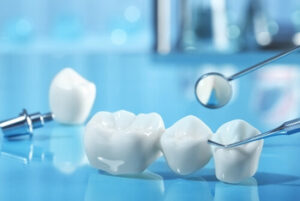Dental crowns are a game-changer for people with damaged teeth, tooth decay, or missing teeth. Whether you’re repairing a cracked tooth or enhancing the appearance of your upper front teeth, getting a tooth crown before and after transformation can be life-changing.
But what should you expect from the procedure? How do dental crowns compare to alternatives like porcelain veneers and bridges? And what does proper care look like to maintain your new smile?
Let’s dive into everything you need to know about tooth crowns, from the crown procedure to their natural appearance and long-term benefits.
Why Would You Need a Tooth Crown?
A tooth crown serves both functional and aesthetic purposes. It protects, strengthens, and enhances the look of natural teeth that have been compromised by damage or decay. You might need a dental crown if you have:
- A cracked tooth that needs reinforcement to prevent further breakage.
- Extensive tooth decay that cannot be repaired with a simple filling.
- A root canal treatment is where the affected tooth needs extra protection.
- A missing tooth requires a dental bridge that relies on crowns for support.
- Old crowns that are worn out and need replacement.
- The desire to improve the natural look of a damaged or misshapen front tooth.
No matter the reason, getting a tooth crown can restore your overall oral health, protect teeth and give you a smile that appears and feels natural.
The Step-by-Step Process: From Temporary to Permanent Crown
The crown procedure typically takes two appointments. Let’s break down what happens before and after you get your tooth crown.
1. First Appointment: Preparing the Tooth
- Your dentist will examine the affected tooth and discuss the best type of crown for you (porcelain crowns, ceramic crowns, or metal-based options).
- If needed, a root canal treatment is performed to remove infection before placing the crown.
- The surrounding teeth are assessed to ensure a good fit.
- The tooth is shaped to make room for the crown.
- Digital scans or impressions are taken to design the crown.
- A temporary crown is placed to shield the tooth while your permanent crown is being made.
2. Second Appointment: Placing the Permanent Crown
- Your temporary crown is removed.
- The permanent crown is evaluated to ensure a proper fit, ideal shape, and a natural look.
- Dental cement is applied to bond the crown securely to your natural tooth.
- The crown is polished to blend seamlessly with your gum line and surrounding teeth.
Before and After: How Dental Crowns Transform Your Smile
The difference between a tooth crown before and after is remarkable. Here’s what you can expect:
Before: The Issues You May Face
- A damaged tooth that affects your confidence and ability to chew.
- Tooth decay causes pain or sensitivity.
- An affected tooth weakens the structure of your surrounding teeth.
- A front tooth with an uneven or worn-down appearance.
After: A Fully Restored and Natural Look
- A strong, fully restored tooth that improves both function and appearance.
- A natural look that integrates seamlessly with your natural teeth.
- Improved function, allowing you to chew and speak comfortably.
- A durable restoration that can last 10–15 years with proper care.
Tooth Crown vs. Other Dental Restorations: What’s Best for You?
A tooth crown can restore both function and appearance, whether for a cracked tooth, severe decay, or cosmetic enhancement. Offering durability and a natural look, it seamlessly blends with your teeth, protecting and enhancing your smile.
Dental Crowns vs. Porcelain Veneers
- Porcelain veneers are ultra-thin shells placed over the front tooth to enhance aesthetics but do not offer the same level of protection as crowns.
- Tooth crowns are recommended for teeth that are structurally compromised, while veneers are ideal for purely cosmetic improvements.
Crowns and Bridges for Missing Teeth
- A dental bridge consists of one or more tooth crowns anchoring an artificial tooth to fill a gap.
- Crowns alone do not replace missing teeth, but they provide crucial support in bridges.
Caring for Your Dental Crown: How to Make It Last
Once your permanent crown is in place, maintaining it with proper care is key to ensuring its longevity.
Daily Care Routine
- Opt for a soft toothbrush to gently clean your teeth and gums.
- Avoid biting hard foods or objects that may crack or loosen the crown.
- Floss daily to prevent decay from forming around the gum line.
Regular Check-Ups
- Schedule regular visits to your dentist for cleanings and check-ups to maintain the health of your tooth crowns and surrounding teeth.
- Your dentist will ensure that the crown remains intact and that there are no signs of decay or gum issues.
The Bottom Line: A Dental Crown Can Be a Game-Changer

With options like ceramic crowns and porcelain crowns, modern dental technology ensures that your smile is both natural-looking and long-lasting. And with proper care, your crown procedure can give you a fully restored smile that boosts your confidence for years to come.
Ready to restore your smile? Book a consultation with Dental 266 today at 02 9051 0600 and take the first step towards a fully restored, natural look.
References
Medical News Today. (n.d.). Root canal treatment: Procedure, benefits, and risks. Retrieved from https://www.medicalnewstoday.com/articles/142780
Cleveland Clinic. (n.d.). Dental crowns. Retrieved from https://my.clevelandclinic.org/health/treatments/10923-dental-crowns







